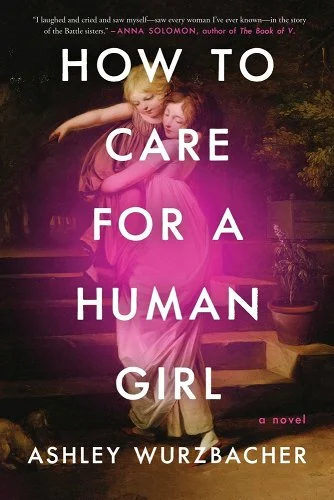[ad_1]
Ashley Wurzbacher’s debut novel, How to Care for a Human Girl, feels exceptionally timely as it explores unwanted pregnancy in the years leading up to the Dobbs decision. Wurzbacher captures the tension caused by inflamed political divides in families and communities around abortion-related healthcare with artifacts of the distinct cultural moment—including the rise in mainly middle-aged men protesting abortion care and the proliferation of anti-abortion billboards. These recognizable details anchor the reader in the midst of the political conversation, which both conveys the stakes of the past abortion care debate and evokes the stress of our current reproductive crisis. But in How to Care for a Human Girl, the politics serve as the context for the characters rather than the focus.
The novel follows the aptly named Battle sisters as they each experience an unplanned pregnancy soon after the death of their mother, Ellen. Although both women are deeply affected by this grief, their circumstances and stages of life are strikingly different. A 30-something PhD student researching the psychological response to choice in online dating, Jada lives in Philadelphia with her husband, an anesthesiologist. She terminates an accidental pregnancy without telling him, prompting a reflection on the state of their marriage. Meanwhile, 19-year-old Maddy still lives in their rural Pennsylvania hometown while working at a wildlife rehabilitation center. Maddy also cleans houses, a job she took over for her mother when she became too ill to work. When Maddy suspects that she is pregnant, she seeks medical care to confirm and offer guidance on her options. She unwittingly goes to a crisis pregnancy center where she ends up no clearer about her options or her decision.
Throughout the novel, Jada and Maddy are both forced to make choices about their futures. For Maddy, she contemplates whether to continue her pregnancy; for Jada, the decision to terminate her pregnancy is a simple one, and it’s whether to stay in her marriage or not that weighs on her. As these sisters wrestle with these heavy life choices, the clever depth of Wurzbacher’s title becomes clear. These decisions involve so much time and contemplation because there are so many ways to care: staying in a marriage and leaving, as well as continuing a pregnancy and terminating it.
It would be easy for a novel with this setup to slip into didacticism or rely on stereotypes for characters—the urban liberal academic, the rural conservative high school graduate—but Wurzbacher avoids this on both counts. The third-person narration isn’t apathetic or disingenuously neutral. The crisis pregnancy center, for instance, is predatory and the employee guilts and manipulates Maddy under the guise of offering support, as we know these institutions operate. But Wurzbacher withholds judgment or intrusion as her characters weigh their own choices and, perhaps more movingly, work through the complicated emotions surrounding their decisions. She approaches Jada and Maddy with impressive compassion and infectious curiosity, a skill that characterizes her other writing, as well. Wurzbacher’s short story collection Happy Like This is similarly populated with full, connected characters who feel deeply.
While Wurzbacher doesn’t rely on stereotypes in How to Care for a Human Girl, she does spend time thoughtfully exploring the differences between Jada and Maddy. The age gap alone did cause a difference in upbringing, in parental relationships, but it was during Ellen’s unexpected pregnancy with Maddy that she was diagnosed with cancer. Maddy grew up with her mother sick; Jada stepped into a caretaker role when her mother wasn’t well enough. Jada’s desire for stability and certainty is evident, and it’s tested early on.
The opening chapter features Jada in the lovely, sterile townhouse she owns with her husband, Blake, a few weeks after she terminated the pregnancy. With the analytical distance befitting her training as a social science researcher, she contemplates why she didn’t tell him and still hasn’t told him. She identifies emotions, questions her motives to withhold, traces the fissures in her marriage, and carefully considers the next steps. When she hears Blake arriving home, she jumps in the closet and hides from him. The impulse is unexpected, but this, too, she unpacks efficiently: “Equal to her fear of being caught was her fear of not being so; his finding might indicate that they were connected by something, some invisible force capable of permeating doors, some connubial sonar in him that pinged in her proximity.” Jada reviews her relationship with Blake, and her relationship with Maddy, as she does the results of her research studies, tracking patterns and searching for reasons among the emotions.
For Maddy, the emotions dominate, and this difference creates distance between the sisters. While Jada withholds and contemplates, Maddy grieves openly, resenting her sister for moving out while she cared for their mother daily. Maddy feels desperately, as any teenager overwhelmed by a crisis might. But Maddy also exhibits profound maturity, particularly as she seeks out support. Whether it’s her trip to the crisis center, her experiment with church, or her outreach to her father, Maddy searches for comfort and companionship in relationships. Of course, it’s her relationship with Jada that offers the most comfort and provides the most meaning. Still, she is reluctant to go to her sister who moved away: “She did not want to need Jada, but deep down, she knew she did. It was a grudging need, and a futile one; Jada wasn’t here.”
Maddy isn’t alone in her “grudging need.” As Maddy and Jada consider their own futures, they’re drawn to each other. They work through the resentments and habits of the past to find a way to repair their relationship. This is the heart of the novel: the story of sisters who figure out how to support each other, how to know each other, and how to love each other regardless of the choices either might make.
As a novel about abortion and pregnancy, How to Care for a Human Girl is inherently concerned with choice. Wurzbacher does a lovely job placing this choice alongside so many others that accumulate to build a life. This includes the big decisions central to the novel—whether to leave home when a parent is ill, whether to leave a marriage, whether to put your desires first—as well as lighter moments, like whether to watch television with your dad or head out on a Friday night, whether to respond to a message on a dating app, or whether to wear a labcoat over your clothes. Early in the novel, faced with three different options for tacos at a grad school party, Jada thinks about the stakes in any decision: “Every choice entails loss, right? Choosing one thing means not choosing something else.” How to Care for a Human Girl explores the anxiety around the inevitable loss in choosing one option over another. But as Jada and Maddy grapple with their big decisions, the novel ultimately shifts focus to what there is to gain from a choice—not only the outcome, but the process. Throughout the novel, Jada and Maddy begin to trust their own desires, to listen to their fears, and to find support in one another. As they choose, these sisters learn how to care, for themselves and for each other.

FICTION
How to Care for a Human Girl
By Ashley Wurzbacher
Atria Books
Published August 8, 2023

[ad_2]
Source link

